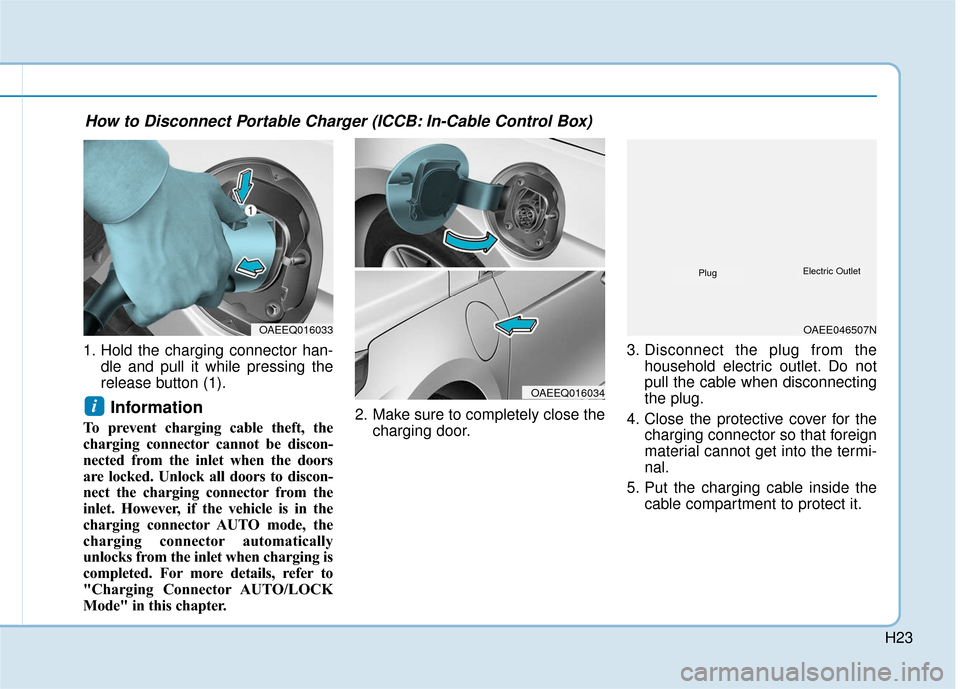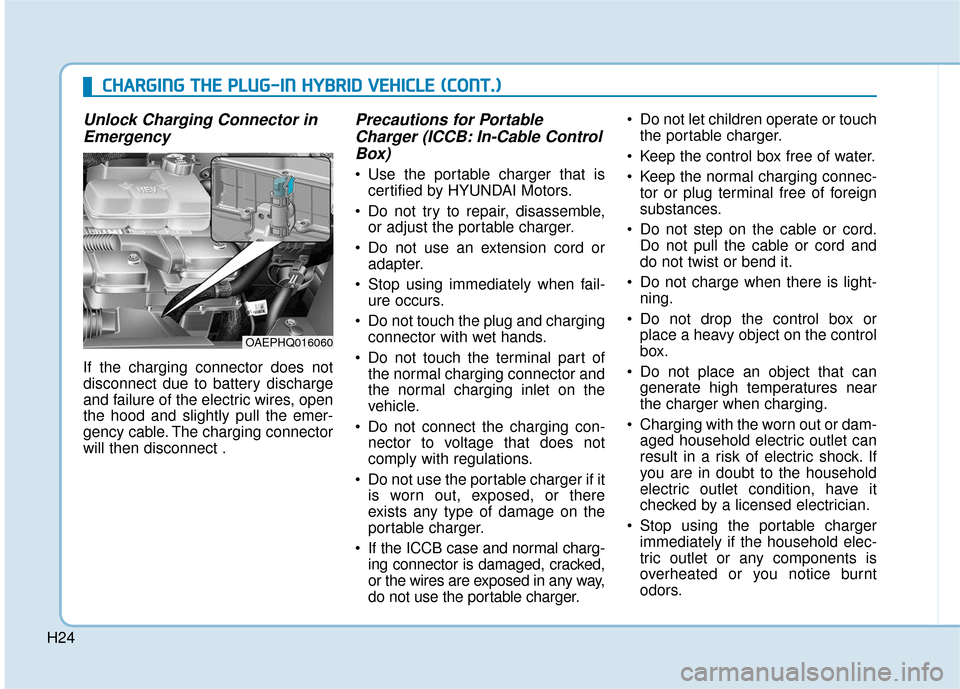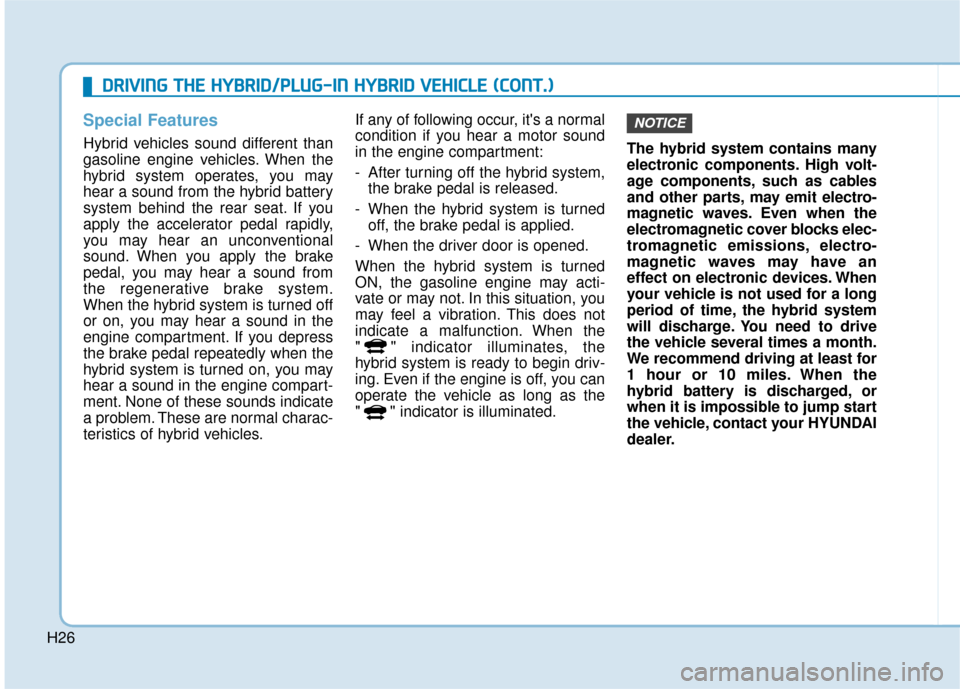2018 Hyundai Ioniq Plug-in Hybrid lock
[x] Cancel search: lockPage 538 of 589

H15
3. Make sure to completely close thecharging door.
Unlock Charging Connector inEmergency
If the charging connector does not
disconnect due to battery discharge
and failure of the electric wires, open
the hood and slightly pull the emer-
gency cable. The charging connector
will then disconnect.
Trickle Charge
(1) Code and Plug (Code set)
(2) Control Box
(3) Charging Cable and Charging
Connector
Trickle Charge can be used when
Normal Charge is not available by
using household electricity.OAEEQ016034
OAEPHQ016060
OAEEQ016042
■
Portable Charger
Page 539 of 589

H16
C
CH
H A
AR
RG
G I
IN
N G
G
T
T H
H E
E
P
P L
LU
U G
G-
-I
IN
N
H
H Y
Y B
BR
RI
ID
D
V
V E
EH
H I
IC
C L
LE
E
(
( C
C O
O N
NT
T.
.)
)
How to Connect Portable
Charger (ICCB: In-Cable ControlBox)
1. Connect the plug to a household
electric outlet. 2. Check if the power lamp (green)
illuminates on the control box.
3. Depress the brake pedal and apply the parking brake.
4. Turn OFF all switches, shift to P (Park), and turn OFF the vehicle. 5. Press center edge of the charging
door to open the charging door.
Information
The charging door opens only when
the door is unlocked.
6. Check if there is dust on thecharging connector and charging
inlet.
i
OAEE046506N
PlugElectric OutletOAEEQ016043
OAEEQ016030
Page 540 of 589

H17
7. Hold the charging connector han-dle and connect it to the vehicle
normal charging inlet. Push the
connector until you hear a "click-
ing" sound. If the charging con-
nector and charging terminal are
not connected properly, this may
cause a fire.
Information
Charging connector AUTO/LOCK
mode
The charging connector is locked in
the inlet at a different period accord-
ing to which mode is selected.
• LOCK mode : The connector lockswhen the charging connector is
plugged into the charging inlet.
• AUTO mode : The connector locks when charging starts.
For more details, refer to "Charging
Connector AUTO/LOCK Mode" in
this chapter. 8. Charging starts automatically
(charging lamp blinks).
i
OAEEQ016031OAEEQ016045
Page 546 of 589

H23
1. Hold the charging connector han-dle and pull it while pressing the
release button (1).
Information
To prevent charging cable theft, the
charging connector cannot be discon-
nected from the inlet when the doors
are locked. Unlock all doors to discon-
nect the charging connector from the
inlet. However, if the vehicle is in the
charging connector AUTO mode, the
charging connector automatically
unlocks from the inlet when charging is
completed. For more details, refer to
"Charging Connector AUTO/LOCK
Mode" in this chapter. 2. Make sure to completely close the
charging door. 3. Disconnect the plug from the
household electric outlet. Do not
pull the cable when disconnecting
the plug.
4. Close the protective cover for the charging connector so that foreign
material cannot get into the termi-
nal.
5. Put the charging cable inside the cable compartment to protect it.
i
OAEEQ016033
OAEEQ016034
OAEE046507N
PlugElectric Outlet
How to Disconnect Portable Charger (ICCB: In-Cable Control Box)
Page 547 of 589

H24
Unlock Charging Connector inEmergency
If the charging connector does not
disconnect due to battery discharge
and failure of the electric wires, open
the hood and slightly pull the emer-
gency cable. The charging connector
will then disconnect .
Precautions for PortableCharger (ICCB: In-Cable ControlBox)
Use the portable charger that is
certified by HYUNDAI Motors.
Do not try to repair, disassemble, or adjust the portable charger.
Do not use an extension cord or adapter.
Stop using immediately when fail- ure occurs.
Do not touch the plug and charging connector with wet hands.
Do not touch the terminal part of the normal charging connector and
the normal charging inlet on the
vehicle.
Do not connect the charging con- nector to voltage that does not
comply with regulations.
Do not use the portable charger if it is worn out, exposed, or there
exists any type of damage on the
portable charger.
If the ICCB case and normal charg- ing connector is damaged, cracked,
or the wires are exposed in any way,
do not use the portable charger. Do not let children operate or touch
the portable charger.
Keep the control box free of water.
Keep the normal charging connec- tor or plug terminal free of foreign
substances.
Do not step on the cable or cord. Do not pull the cable or cord and
do not twist or bend it.
Do not charge when there is light- ning.
Do not drop the control box or place a heavy object on the control
box.
Do not place an object that can generate high temperatures near
the charger when charging.
Charging with the worn out or dam- aged household electric outlet can
result in a risk of electric shock. If
you are in doubt to the household
electric outlet condition, have it
checked by a licensed electrician.
Stop using the portable charger immediately if the household elec-
tric outlet or any components is
overheated or you notice burnt
odors.
OAEPHQ016060
C
CH
H A
AR
RG
G I
IN
N G
G
T
T H
H E
E
P
P L
LU
U G
G-
-I
IN
N
H
H Y
Y B
BR
RI
ID
D
V
V E
EH
H I
IC
C L
LE
E
(
( C
C O
O N
NT
T.
.)
)
Page 549 of 589

H26
D
DR
RI
IV
V I
IN
N G
G
T
T H
H E
E
H
H Y
Y B
BR
RI
ID
D /
/P
P L
LU
U G
G-
-I
IN
N
H
H Y
Y B
BR
RI
ID
D
V
V E
EH
H I
IC
C L
LE
E
(
( C
C O
O N
NT
T.
.)
)
Special Features
Hybrid vehicles sound different than
gasoline engine vehicles. When the
hybrid system operates, you may
hear a sound from the hybrid battery
system behind the rear seat. If you
apply the accelerator pedal rapidly,
you may hear an unconventional
sound. When you apply the brake
pedal, you may hear a sound from
the regenerative brake system.
When the hybrid system is turned off
or on, you may hear a sound in the
engine compartment. If you depress
the brake pedal repeatedly when the
hybrid system is turned on, you may
hear a sound in the engine compart-
ment. None of these sounds indicate
a problem. These are normal charac-
teristics of hybrid vehicles. If any of following occur, it's a normal
condition if you hear a motor sound
in the engine compartment:
- After turning off the hybrid system,
the brake pedal is released.
- When the hybrid system is turned off, the brake pedal is applied.
- When the driver door is opened.
When the hybrid system is turned
ON, the gasoline engine may acti-
vate or may not. In this situation, you
may feel a vibration. This does not
indicate a malfunction. When the
" " indicator illuminates, the
hybrid system is ready to begin driv-
ing. Even if the engine is off, you can
operate the vehicle as long as the
" " indicator is illuminated. The hybrid system contains many
electronic components. High volt-
age components, such as cables
and other parts, may emit electro-
magnetic waves. Even when the
electromagnetic cover blocks elec-
tromagnetic emissions, electro-
magnetic waves may have an
effect on electronic devices. When
your vehicle is not used for a long
period of time, the hybrid system
will discharge. You need to drive
the vehicle several times a month.
We recommend driving at least for
1 hour or 10 miles. When the
hybrid battery is discharged, or
when it is impossible to jump start
the vehicle, contact your HYUNDAI
dealer.
NOTICE
Page 572 of 589

H49
The cooling duct cools down the
high-voltage battery. When the high-
voltage battery cooling duct is
blocked, the high-voltage battery
may be overheated and the vehicle
performance may become limited
and set a hybrid warning lamp. Do
not obstruct the cooling duct with any
other objects.
Information
Clean the cooling duct for the hybrid
battery with a dry cloth on a regular
basis.
i
(Continued)
Do not put any objects into
the cooling duct of the hybrid
battery. Doing so may cause
loss of cooling duct volume to
the hybrid battery. When the
cooling duct is blocked with
any objects, immediately con-
tact your HYUNDAI dealer.
Never place a container of liq-
uid on or near the cooling
duct. If the liquid spills, the
hybrid battery located in the
luggage compartment may be
damaged.
Secure all loads in the luggage
compartment to prevent them
from being tossed about
before driving. If a sharp or
heavy load impacts or pierces
the interior luggage compart-
ment wall, the hybrid battery
system may be damaged, dete-
riorating its performance.
Never clean the cooling duct
of the hybrid battery with a
wet cloth. If any water enters
in the cooling duct of the
hybrid battery, the hybrid bat-
tery may cause an electric
shock, serious damage, injury
or death.
The hybrid battery is com-
posed of lithium-ion polymer.
If the hybrid battery is improp-
erly handled, it is dangerous
to the environment. Also it
may cause electrical shock
and severe burns, resulting in
serious injury or death.
Do not spill liquid over the
cooling duct of the hybrid bat-
tery. Doing so is very danger-
ous. It may cause electric
shock or serious injury.
Do not cover the cooling duct
with objects.(Continued)
WARNING
Page 576 of 589

I-2
Air bag warning labels ....................................................2-70
Air bags ........................................................................\
...2-47Additional safety precautions .....................................2-69
Air bag collision sensors ............................................2-63
Air bag inflation conditions .......................................2-65
Air bag non-inflation conditions ................................2-66
Air bag warning labels ...............................................2-70
Curtain air bags ..........................................................2-51
Do not install a child restraint on the front passenger seat..........................................................2-62
Driver's air bag ...........................................................2-49
Driver's knee airbag....................................................2-49
How does the air bags system operate? .....................2-52
Occupant Classification System (OCS) .....................2-58
Passenger’s front air bag ............................................2-49
Side air bags ...............................................................2-50
SRS Care ....................................................................2-68\
SRS components and functions..................................2-52
SRS warning light ......................................................2-53
What to expect after an air bag inflates .....................2-57
Why didn't my air bag go off in a collision ...............2-63
Air cleaner.......................................................................7\
-24
Air conditioning refrigerant label .................................3-140
Air conditioning system specification ..............................8-6
Air conditioning system................................................3-129
Alarm system ..................................................................3-13 Antenna ........................................................................\
.....4-2
Anti-lock Brake System (ABS) ......................................5-26
Appearance care..............................................................7-67
Exterior care ...............................................................7-67
Interior care ................................................................7-71
Armrest ........................................................................\
...2-15
Audio/Video/Navigation system (AVN system)...............4-5
Auto defogging system .................................................3-143
Auto door lock/unlock features Impact sensing door unlock .......................................3-12
Shift lever auto door lock ...........................................3-12
Speed sensing door lock .............................................3-12
Auto light position ........................................................3-115
Automatic climate control system ................................3-129 Air conditioning .......................................................3-137
Air conditioning refrigerant label.............................3-140
Air intake control .....................................................3-135
Automatic heating and air conditioning ...................3-130
Driver only ...............................................................3-137
Fan speed control .....................................................3-136
Manual heating and air conditioning .......................3-131
Mode selection .........................................................3-132
OFF mode.................................................................3-137
Sync button...............................................................3-134
System maintenance .................................................3-139
Temperature control .................................................3-134
Index
A